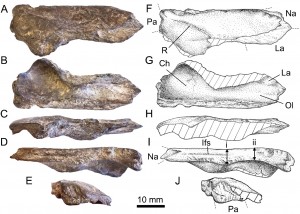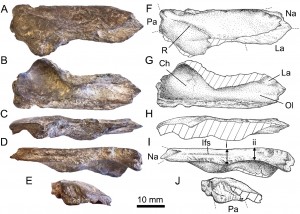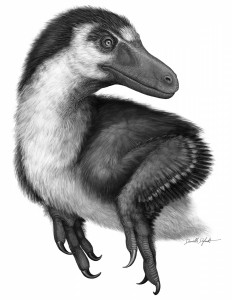
There is a new raptor dinosaur (dromaeosaur) in town. Boreonykus certekorum (meaning “Certek’s northern claw”) is the newest dinosaur named from the Peace Region. Recently described by former Philip J. Currie Dinosaur Museum palaeontologist Phil Bell and our namesake Philip Currie, this new species hails from the Pipestone Creek bonebed that features prominently in the galleries here at the museum.
For those of you unfamiliar with our museum, the Philip J. Currie Dinosaur Museum is situated near the Pipestone Creek bonebed, one of the densest dinosaur fossil sites in the world. The site is a monodominant bonebed of the horned dinosaur Pachyrhinosaurus lakustai. But even though remains of Pachyrhinosaurus dominate the site, it’s not the only dinosaur remains we find there. With the description of Boreonykus, the first identifiable meat-eating dinosaur found from the area, the number of new species from the Pipestone Creek bonebed now stands at two.

Boreonykus certekorum holotype specimen, a frontal bone from the roof of the skull. From Bell and Currie (2015).
The fossils, which consist of a frontal skull bone (the holotype specimen), both a hand and a foot claw, a tail vertebra, and several teeth, were all recovered from the Pipestone Creek bonebed over a series of excavations through the bonebed’s history. Recently, when compared to other dromaeosaurs, it was found to be a distinct species most closely related to a group of Asian dromaeosaurs, a group including Velociraptor (of Jurassic Park and World fame) and with only one other North American representative, Acheroraptor temertyorum from the Hell Creek Formation of Montana (more on that later).
One of the reasons this find is particularly significant is the period of time in which it lived. Boreonykus and Pachyrhinosaurus lakustai are recovered from a section of the Wapiti rock formation that is the same age as the Bearpaw Formation which occurs in much of southern and eastern Alberta. The Bearpaw Formation is a marine unit that marks when the sea level of the shallow inland sea that covered the centre of North America at that time rose and flooded much of North America. Only in the areas closest to the uplifting Rocky Mountains stayed above sea level, a necessary requirement to be populated by land-loving dinosaurs. The dinosaurs below the Bearpaw and above the Bearpaw are different from each other, indicating that sometime during that period of high sea-level, the fauna in North America changed. Boreonykus and Pachyrhinosaurus lakustai are some of the few known dinosaur species from this transitional time period anywhere in North America.

Acheroraptor temertyorum from the Hell Creek Formation of Montana, possible close relative of Boreonykus. Image credit Danielle Dufault.
It is also intriguing that the species was found to be more closely related to Asian dromaeosaurs than to most other North American dromaeosaurs. In fact, the only other North American species it is closely related to is another oddity, Acheroraptor temertyorum, one of the last North American dromaeosaurs at the end of the Cretaceous. If these results stand up to scrutiny after more complete material is discovered, finding Boreonykus in northern Alberta might be a good explanation for where North American velociraptorines were living before they appeared suddenly at the end of the Cretaceous. However, both Boreonykus and Acheroraptor are both only known from a few bones, and the only elements that they both share are teeth, so it is difficult to say exactly how closely related the two species are. This is further complicated by there being two distinct types of teeth referred to Boreonykus. As somewhat of a dinosaur tooth specialist, this brings a number of questions to my mind. Do both types of teeth belong to Boreonykus? If not, which ones are actually Boreonykus? Are the relationships of the new species dependent on the correct identification of these isolated teeth? As you can see, there are still a lot of unanswered questions about the relationship of this new taxon and the implications of that relationship for dinosaur immigration to North America. Future study is certainly warranted, and hopefully, new remains of Boreonykus will be discovered.

Boreonykus certekorum referred teeth. Note the different denticle (serration) shapes in parts C and E. From Bell and Currie (2015).
I got in touch Phil Bell, the lead author of the study, to ask him some questions about Boreonykus and its environment. Here is what he had to say.
Q: What is Boreonykus certekorum?
A: Boreonykus is the newest species that belongs to the group of dinosaurs known as dromaeosaurs. They were generally big dog-sized predators that include such famous species as Velociraptor and Deinonychus.
Q: What is the significance of Boreonykus to the Peace Region?
A: Boreonykus is only the second new species to be discovered in the Peace and only the third species to be confidently identified. Although we know there were plenty of other types of dinosaurs in the area at the time, our identifications of those animals are much less precise.
Q: What does this dinosaur tell us about northern dinosaurs?
A: Northern dinosaurs – and in fact many dinosaurs along the Western Interior of North America – seem to have been very choosy about where they lived. In fact many species only appear to have lived in a restricted area because they were suited to a particular environment or a particular climate. So you can can think of them not like sparrows – which are found all over the world – but more like polar bears or penguins: they could only survive in a particular habitat that they were suited to.
Q: Can you talk a little bit about the evidence for scavenging in the Pipestone Creek bonebed?
A: Yes, the Pipestone bonebed is littered with thousands of bones of Pachyrhinosaurus but among them we find a small number of broken theropod teeth, which probably belong to Boreonykus. Theropods, like all dinosaurs, continually replaced their teeth as they grew, much like sharks to do today. So whenever they had a wiggly tooth and they bit down on something hard – like a bone – the tooth would drop out. So what we think happened was that packs of Boreonykus converged on the huge stinking mounds of rotting carcasses of Pachyrhinosaurus to dine.
Q: How did Boreonykus come to be preserved in the bonebed?
A: It’s difficult to know but certainly the teeth and bones of Boreonykus represent at least two different individuals. The teeth arrived later, after the Pachyrhinosaurus had died, but the bones of Boreonykus appeared either before or during the same episode that killed the [group of] Pachyrhinosaurus. We don’t know what actually killed all these animals – probably they were killed in a flood, and it would not be hard for a flood to wipe out a number of species in the area.
For more information about Boreonykus and Acheroraptor, you can follow these links for the original scientific descriptions. For more information about the Pipestone Creek bonebed, be sure to come into the Philip J. Currie Dinosaur Museum to check out our galleries. That’s all for this week. Talk to you again soon!
By Derek Larson
Reference:
Bell, P. R., and P. J. Currie. 2015. A high-latitude dromaeosaurid, Boreonykus certekorum, gen. et sp. nov. (Theropoda), from the upper Campanian Wapiti Formation, west-central Alberta. Journal of Vertebrate Paleontology. DOI: 10.1080/02724634.2015.1034359.
